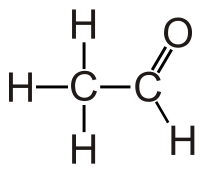Acetaldehyde: Difference between revisions
Uncle Jesse (talk | contribs) (Adding image) |
Uncle Jesse (talk | contribs) (Deleting specific wine styles) |
||
| (2 intermediate revisions by the same user not shown) | |||
| Line 2: | Line 2: | ||
Definition from [[The Alcohol Textbook]]: | Definition from [[The Alcohol Textbook]]: | ||
Acetaldehyde, otherwise known as [[ethanol]], acetic aldehyde or | Acetaldehyde, otherwise known as [[ethanol]], acetic aldehyde or ethyl aldehyde. A clear flammable liquid with a characteristic pungent odor. Chemical formula CH<sub>3</sub>CH<sub>O</sub>. Boils at 21°C and freezes at -123.5°C. It is miscible in both ethanol and [[water]]. It has a narcotic effect on humans, and large doses may cause death by respiratory paralysis. It is a [[congener]] in the production of ethanol by fermentation, and is usually a major constituent of the [[heads]] fraction removed in [[rectification]]. | ||
A colorless, volatile, and water-soluble compound found naturally in [[ | A colorless, volatile, and water-soluble compound found naturally in [[grape]]s and [[wine]]s in trace amounts and produced both by [[fermentation]] and [[oxidation]]. It has a pungent, fruit-like odor and is desirable in small amounts in good table wines and in high amounts in oxidized wines such as Sherry or Madeira. During fermentation, it is produced by [[yeast]] in the fourth of five stages of enzymatic action culminating in the production of [[Ethanol|ethyl alcohol]]. The [[enzyme]] carboxylase forms [[acetaldehyde]] and [[carbon dioxide]] from pyruvic acid. At the next (final) stage, most of the acetaldehyde is reduced to ethyl alcohol, but a trace remains and adds to the flavor and complexity of the wine. If too much remains, it taints the wine with a strong, oxidized off-taste. | ||
[[Category:Glossary]] | [[Category:Glossary]] | ||
Latest revision as of 08:50, 14 December 2022
Definition from The Alcohol Textbook:
Acetaldehyde, otherwise known as ethanol, acetic aldehyde or ethyl aldehyde. A clear flammable liquid with a characteristic pungent odor. Chemical formula CH3CHO. Boils at 21°C and freezes at -123.5°C. It is miscible in both ethanol and water. It has a narcotic effect on humans, and large doses may cause death by respiratory paralysis. It is a congener in the production of ethanol by fermentation, and is usually a major constituent of the heads fraction removed in rectification.
A colorless, volatile, and water-soluble compound found naturally in grapes and wines in trace amounts and produced both by fermentation and oxidation. It has a pungent, fruit-like odor and is desirable in small amounts in good table wines and in high amounts in oxidized wines such as Sherry or Madeira. During fermentation, it is produced by yeast in the fourth of five stages of enzymatic action culminating in the production of ethyl alcohol. The enzyme carboxylase forms acetaldehyde and carbon dioxide from pyruvic acid. At the next (final) stage, most of the acetaldehyde is reduced to ethyl alcohol, but a trace remains and adds to the flavor and complexity of the wine. If too much remains, it taints the wine with a strong, oxidized off-taste.
